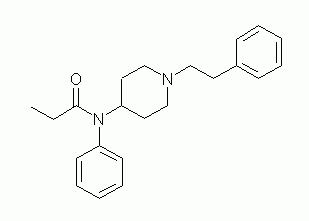Fentanyl
Fentanyl is an opioid analgesic, first synthesized in Belgium in the late 1950s, with an analgesic potency of about 80 times that of morphine. It was introduced into medical practice in the 1960s as an intravenous anesthetic under the trade name of Sublimaze. Fentanyl has an LD50 of 3.1 milligrams per kilogram in rats. The LD50 in humans is not known. Fentanyl is a Schedule II drug. more...
Analogues
The pharmaceutical industry has developed several analogues of fentanyl:
- Alfentanil (Alfenta), an ultra-short acting (5–10 minutes) analgesic,
- Sufentanil (Sufenta), a potent analgesic (15 to 10 times more potent than fentanyl) for use in heart surgery.
- Remifentanil, currently the shortest acting opioid, has the benefit of rapid offset, even after prolonged infusions.
- Carfentanil (Wildnil) is an analogue of fentanyl with an analgesic potency 10,000 times that of morphine and is used in veterinary practice to immobilize certain large animals.
Therapeutic use
Today, fentanyls are extensively used for anesthesia and analgesia. Duragesic, by Janssen Pharmaceutica, is a fentanyl transdermal patch used in chronic pain management. In the past few years, this compound has gone generic and is available for lower cost. Duragesic is manufactured in five patch sizes. They are 12.5 mcg/hr, 25 µg/h, 50 µg/h, 75 µg/h, and 100 µg/h. Dosage is based on the size of the patch, since the transdermal absorption rate is generally constant at skin temperature.
Actiq, by Cephalon, is a recently-developed solid formulation of fentanyl citrate on a stick that dissolves slowly in the mouth for transmucosal absorption. Actiq is intended for opiate-tolerant individuals and is effective in treating breakthrough cancer pain. It is also useful for breakthrough pain for those suffering bone injuries, severe back pain, neuropathy, arthritis, and some other examples of chronic nonmalignant pain. The unit is a berry-flavored lozenge on a stick which is swabbed on the mucosal surfaces inside the mouth - under and on the tongue and gums—to release the fentanyl quickly into the system. It is most effective when the lozenge is consumed in 15 minutes. The drug is practically ineffective if swallowed, absorption from the alimentary tract being negligible. Actiq is available in 6 dosages, from 200 µg to 1,600 µg (There are no 1,000 µg or 1,400 µg doses)in 200 µg increments.
Fentanyl is frequently given intrathecally as part of spinal anesthesia or epidurally for epidural anesthesia and analgesia.
Illicit use
Illicit use of pharmaceutical fentanyls first appeared in the mid-1970s in the medical community and continues to be a problem in the United States. United States authorities classify fentanyl as a narcotic. To date, over 12 different analogues of fentanyl have been produced clandestinely and identified in the U.S. drug traffic. The biological effects of the fentanyls are indistinguishable from those of heroin, with the exception that the fentanyls may be hundreds of times more potent. Also, fentanyl has a shorter duration than heroin does. Fentanyls are most commonly used by intravenous administration, but like heroin, they may also be smoked or snorted. One common street name for fentanyl is china white. This is not always accurate, as it was originally given to alpha-methyl-fentanyl, although in recent years this terminology has faded somewhat. AMF has longer metabolism than fentanyl because the methyl group retards metabolism.
Read more at Wikipedia.org



